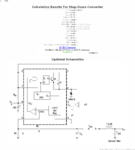tlogic
Member level 1

Yes the timebase is 5us/div. The inductors are 2x22uH/1A connected in series. The voltage across the current resistor (0R2) is 11.13V at one end and 11.10 to the other. So the difference voltage is 0.02V thus I=0.1A if you mean this.







